Email marketing continues to be a top performing channel for marketers. Year after year, email outperforms other marketing channels in terms of ROI, customer acquisition and retention. Take a look at some of these recently published statistics in our recent blog post.
- For every dollar brands invest in email marketing, they receive 42 dollars in return. (Litmus)
- 77% of marketers say email is one of their two most effective marketing channels and 78% of marketing executives indicate email marketing is vital to the overall success of their company. (Litmus, 2020)
- Just 16% of respondents believe their company measures email marketing’s ROI well or very well. Furthermore, 45% cited ROI measurement of email marketing efforts as poor, very poor, or non-existent. (Litmus, 2020)
- According to 80% of professionals, email marketing drives customer acquisition and retention. (eMarketer)
- Shoppers spend 138% more when marketed to through email, as compared to those who do not receive email offers. (Disruptive Advertising)
Email Marketing Objectives
In research by DemandMetric and Return Path from Validity, The State of Email Marketing 2021 Report, respondent stated that communications and brand awareness were top email marketing objectives:
- 71% – Communicate with customers
- 69% – Build brand awareness
- 64% – Communicate with prospects
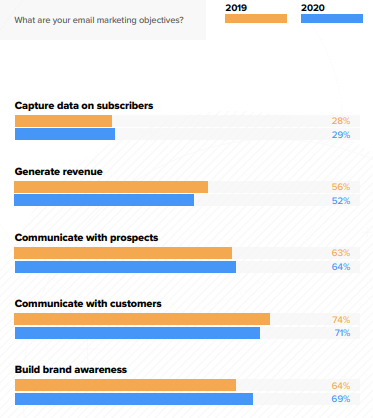
These findings are consistent with their research finding in 2019. When asked to list their top three email marketing objectives, respondents overall cited communicating with customers (74%), building brand awareness (64%) and communicating with prospects (63%).
However, when these finding were broken out by B2B and B2C, objectives varied slightly. Communicating with customers was a primary goal for marketers of both groups (78% B2C, 74% B2B). For B2C email marketers, generating revenue was a primary objective (80% B2C, 41% B2B) and for B2B marketers, communication with prospects was cited as a primary objective (73% B2B, 54% B2C).
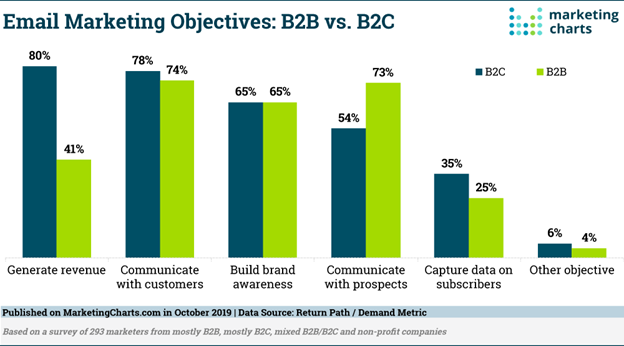
In a 2019 study by marketers Convince & Convert, 67% of email marketers stated that their primary objective was to increase engagement, however this was also a top challenge for 50% of marketers.
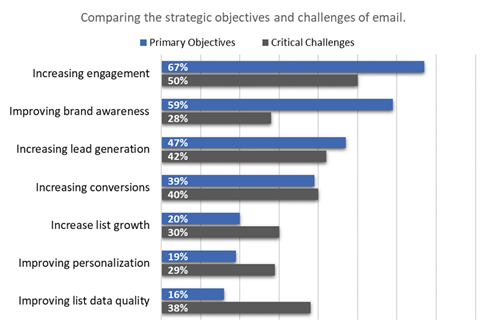
Competition for Attention in the Inbox is a Primary Challenge
While email may have great potential, that doesn’t mean it is without its challenges. 42% of respondents in DemandMetric’s research stated that getting noticed in crowded inboxes was a primary challenge. This was followed by poor email engagement (35%) and email deliverability challenges (30%).
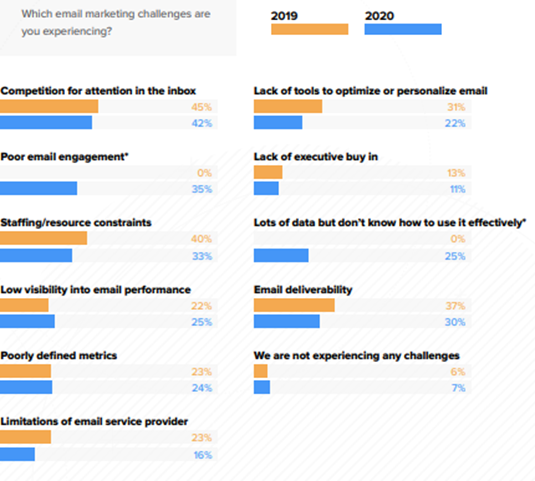
According to Litmus, some of the biggest challenges in a 2019 study included lack of quality data, poor coordination between other departments and channels, insufficient staffing, and limitations of the current email service provider.
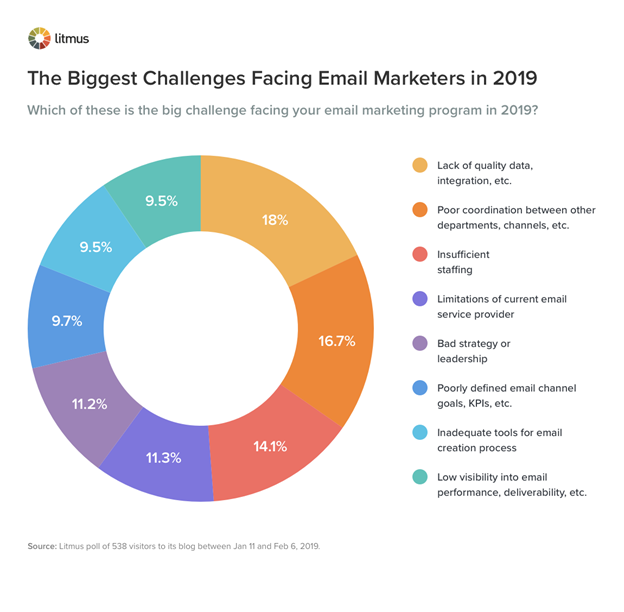
Email Marketing Tactics
Unfortunately, email marketers are becoming less sophisticated in their approach to email marketing when compared to the previous year. In 2019, 63% of marketer were using list management services compared to 56% in 2020. Other tactics were also on the decline including optimizing subject lines, performing A/B testing, and optimizing for email deliverability.
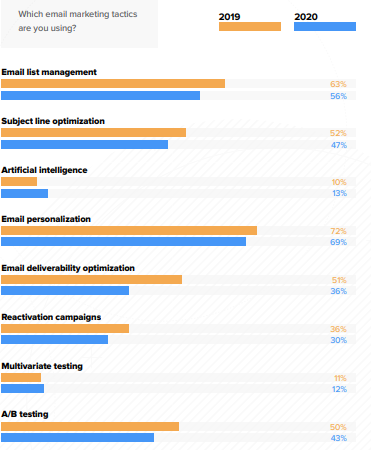
Marketers need to get back on track and improve in these areas. Not doing so is only compounding the problem of not getting noticed in busy inboxes and is leaving revenue on the table.
For example:
- 47% of people open the emails based on the subject line. (OptinMonster)
- A study by Experian found that email subject lines with an emoji increased open rates by 56%, as compared to text-only subject lines. (Campaign Monitor)
- Emails with personalized subject lines are 50% more likely to be opened. (Oberlo)
- Segmented email marketing campaigns can lead to revenue increases of as much as 760%. (Campaign Monitor)
To take your email success to the next level, make sure you have some of the basics in place:
Segment Your Email List
When it comes to sending more effective email campaigns and boosting email open rates, list segmentation goes a long way. In fact, segmented email marketing campaigns can lead to revenue increases of as much as 760%. (Campaign Monitor)
List segmentation is all about creating more personalized content for your emails. The segments can be as large or as small as you want, but the more targeted the segment, the more it will resonate with your customers. Email segmentation doesn’t need to be a daunting task either – simply starting with when a purchase was last made is a start. But the larger your database and the more varied your product portfolio, the more sophisticated your techniques should become.
The most successful email marketers understand the importance of using data to drive focused campaigns. Data about each of your customer interactions must be combined into one consolidated customer view. Any number of segmentation strategies can then be applied to create hyper-targeted lists.
For example, a clothing retailer may consider creating segments for females between the ages of 28-34 with a combined household income of $150,000 and who have indicated interests in fashion. These consumers have made new item purchases within the last 4 weeks totaling over $150 and are ideal candidates for accessory purchases. Armed with these insights into demographics and purchase history, a marketer can deploy emails with personalized offers such as “Hello Mary. Thank you for your recent purchase from our summer dress line. We thought these accessories would go great with your new dress.” Your customer will appreciate the personalized recommendation as you happily cross-sell her additional products.
Design for Mobile – Always
First and foremost, if you aren’t designing your emails for mobile devices, chances are that your message is not getting the attention it deserves. Mobile-friendly design is one of the most crucial components for successful mobile email marketing. In fact, 80% of users will delete an email if it does not look good on their mobile devices, according to Blue Hornet. So for those who say that email marketing is dead, they are probably not using responsive design.
Pay attention to your copy. A great subject line can boost your email open rates but a good rule of thumb is to keep it below 50 characters. Your opening line must be relevant and compelling since this is what will appear in the preview window on mobile devices.
The body copy should also be easy to read on any size device. Use subheadings, short paragraphs, and plenty of line breaks. Also avoid content that requires too much clicking or scrolling. There are plenty of email guides and best practicing on how to incorporate a mobile-friendly design into your email so be sure to do your research and implement mobile-first design best practices.
Automate Your Email Journeys
Using automated journey management, email marketers can more easily integrate personalization into their email strategies.
Sending triggered emails based on a consumer’s behavior is effective for both acquisition and transforming customers into loyal brand advocates.
Check out these stats on the effectiveness of email marketing automation:
- Automated emails get 119% higher click rates than broadcast emails. (Epsilon)
- B2C marketers who connect with customers through automated emails see conversion rates as high as 50%. (eMarketer)
- Relevant emails drive 18x more revenue than broadcast emails. (Jupiter Research)
- Retailers who send a series of welcome emails see 13% more revenue than those who send just one. (Internet Retailer 500)
While many brands are very familiar with welcome emails or order confirmations, email automation and personalization must be holistically integrated throughout the journey to increase conversions and boost retention.
Consider using a customer data platform to automate email journeys. Using a CDP, marketers can easily create campaigns that recognize if customers have visited a brand’s website, browsed certain product categories, opened emails or visited stores.
For email marketers, getting through to your email’s inbox is only half the battle. Capturing your customer’s attention is the true testament to a well-crafted email based on targeted communications and a well-managed database.
Download Porch Group Media’s success kit on Email Marketing Strategies – full of blogs, articles, webinars and resources to help you learn the latest trends and best practices to boost your email marketing success.






